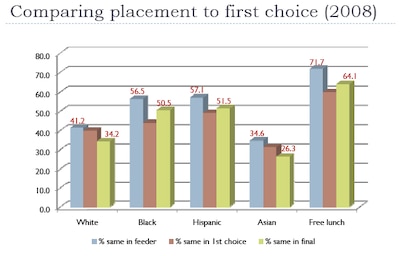
When black and Hispanic students sit down to fill out their high school application forms, they tend to prioritize schools that are better performing and more racially diverse than their middle schools, which are on average, lower-performing and more racially isolated. But a study shows that the schools that actually accept them are more like the middle schools they come from.
That’s one of the findings in a study that tries to begin to understand the mysteries behind the city’s enormously complex high school selection process. Completed by New York University Assistant Professor Sean Corcoran and Teachers College Professor Henry Levin, the study was presented at a forum on high school choice at the New School today and also appears in the book Education Reform in New York City that was published this month.
Corcoran and Levin’s findings are interesting not only as an insight into why some students make the choices they do. They also add depth to the core claim of Mayor Bloomberg’s reforms: that by expanding students’ options for where they go to school, the quality of their education will improve.
Among the study’s other findings are:
- The average number of programs that students list — they can name up to 12 — has fallen between 2004 when the new high school admissions policy began and 2008, when the study’s most recent data was gathered. Still, about 21 percent of eighth graders list the maximum of 12 schools. About seven percent of students only write one school on their list, but 82 percent of them were matched to this choice. There are a handful of explanations for this high matching rate. One is that these students applied only to their zoned school, or a guidance counselor applied for them. Another is that they applied to continue on into ninth grade at their current school.
- A student’s socioeconomic background, academic strength, and neighborhood all have a hand in influencing how many programs they list. Students in the Bronx and Manhattan listed more choices than their peers in Staten Island, Queens, and Brooklyn. Students who were economically and academically disadvantaged were more likely to rank more choices than their advantaged peers.
- A student’s middle school guidance counselor also matters. Controlling for other predictive factors, Corcoran and Levin found that students submit shorter or longer lists depending on their middle school. The study says: “Counselors are ultimately responsible for submitting applications, and thus may have a high degree of influence on the number of choices.”
- Low achieving students were more likely to rank schools with low graduation rates and largely low-income student bodies as their first choice. Students who were in the bottom third in math picked schools with an average four-year graduation rate of 66 percent and schools that were unlikely to have an A on their most recent report card.
- White students, students from Staten Island, and students who aren’t fluent in English were more likely to rank the school closest to their home as their first choice than were black students. Only 8 percent of black students did so, whereas the citywide average was 14 percent.
Members of a panel moderated by New School Center for NYC Affairs senior editor Clara Hemphill discussed how guidance counselors and enrollment centers can affect where students apply to high school.
A doctoral candidate at New York University, Carolyn Sattin-Bajaj said that at one of the middle schools she’s spent time in, where many students come from low-income, immigrant families, guidance counselors filled out high school admission rankings for about 20 students without the students’ input. She said that using the percentage of students who get their first choice school as an indication of how well the system is working could be misleading.
“Getting your first ranked school doesn’t necessarily mean that a kid did a lot of research,” she said. “The kids didn’t turn in their applications so the guidance counselor put down their zoned school as their first choice and they got it.”
Carol Boyd, a member of the New Settlement Apartments Parent Action Committee, said she re-wrote the city’s guide to high schools to make it more accessible to parents in her Bronx neighborhood. On their own, the schools’ guidance counselors couldn’t make the process clear to students and parents, she said.
Recently named CEO of the Department of Education’s Enrollment Office Robert Sanft said that the DOE had improved communication with parents about the process. This year, it added schools’ graduation rates to the high school directory, which caused more students to apply to high performing schools. Sanft said that supply and demand remains a problem for the DOE — the isn’t creating good schools fast enough, he said.
Corcoran and Levin’s study does not include two groups of high school students: those coming from private schools and those who move to the city after the application process is over and are known as “over the counter” students.
